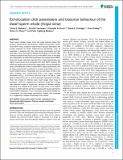Files in this item
Echolocation click parameters and biosonar behaviour of the dwarf sperm whale (Kogia sima)
Item metadata
| dc.contributor.author | Malinka, Chloe E | |
| dc.contributor.author | Tønnesen, Pernille | |
| dc.contributor.author | Dunn, Charlotte A | |
| dc.contributor.author | Claridge, Diane E | |
| dc.contributor.author | Gridley, Tess | |
| dc.contributor.author | Elwen, Simon H | |
| dc.contributor.author | Teglberg Madsen, Peter | |
| dc.date.accessioned | 2022-03-26T00:41:18Z | |
| dc.date.available | 2022-03-26T00:41:18Z | |
| dc.date.issued | 2021-03-26 | |
| dc.identifier | 274691053 | |
| dc.identifier | 638f32b0-7260-4fe3-89dc-9cb4680c6ef6 | |
| dc.identifier | 33771935 | |
| dc.identifier | 85103608262 | |
| dc.identifier | 000636462900018 | |
| dc.identifier.citation | Malinka , C E , Tønnesen , P , Dunn , C A , Claridge , D E , Gridley , T , Elwen , S H & Teglberg Madsen , P 2021 , ' Echolocation click parameters and biosonar behaviour of the dwarf sperm whale ( Kogia sima ) ' , Journal of Experimental Biology , vol. 224 , no. 6 , jeb240689 . https://doi.org/10.1242/jeb.240689 | en |
| dc.identifier.issn | 0022-0949 | |
| dc.identifier.other | ORCID: /0000-0002-4274-7239/work/95772489 | |
| dc.identifier.uri | https://hdl.handle.net/10023/25110 | |
| dc.description | PhD and fieldwork funding were provided by the Danmarks Grundforskningsfond (27125 to P.T.M.), the Oticon Fonden (18-0340 to C.E.M.) the Dansk Akustisk Selskab (to C.E.M.), the South Africa National Research Foundation (research career advancement fellowship to S.E.) and the Claude Leon Foundation (postdoctoral fellowship to T.G.). | en |
| dc.description.abstract | Dwarf sperm whales (Kogia sima) are small toothed whales that produce narrow-band high-frequency (NBHF) echolocation clicks. Such NBHF clicks, subject to high levels of acoustic absorption, are usually produced by small, shallow-diving odontocetes, such as porpoises, in keeping with their short-range echolocation and fast click rates. Here, we sought to address the problem of how the little-studied and deep-diving Kogia can hunt with NBHF clicks in the deep sea. Specifically, we tested the hypotheses that Kogia produce NBHF clicks with longer inter-click intervals (ICIs), higher directionality and higher source levels (SLs) compared with other NBHF species. We did this by deploying an autonomous deep-water vertical hydrophone array in the Bahamas, where no other NBHF species are present, and by taking opportunistic recordings of a close-range Kogia sima in a South African harbour. Parameters from on-axis clicks (n=46) in the deep revealed very narrow-band clicks (root mean squared bandwidth, BWRMS, of 3±1 kHz), with SLs of up to 197 dB re. 1 µPa peak-to-peak (μPapp) at 1 m, and a half-power beamwidth of 8.8 deg. Their ICIs (mode of 245 ms) were much longer than those of porpoises (<100 ms), suggesting an inspection range that is longer than detection ranges of single prey, perhaps to facilitate auditory streaming of a complex echo scene. On-axis clicks in the shallow harbour (n=870) had ICIs and SLs in keeping with source parameters of other NBHF cetaceans. Thus, in the deep, dwarf sperm whales use a directional, but short-range echolocation system with moderate SLs, suggesting a reliable mesopelagic prey habitat. | |
| dc.format.extent | 16 | |
| dc.format.extent | 1561745 | |
| dc.language.iso | eng | |
| dc.relation.ispartof | Journal of Experimental Biology | en |
| dc.subject | Beam pattern | en |
| dc.subject | Bioacoustics | en |
| dc.subject | Hydrophone array | en |
| dc.subject | Narrow-band high-frequency | en |
| dc.subject | Passive acoustic monitoring | en |
| dc.subject | Source parameters | en |
| dc.subject | GC Oceanography | en |
| dc.subject | DAS | en |
| dc.subject | NIS | en |
| dc.subject.lcc | GC | en |
| dc.title | Echolocation click parameters and biosonar behaviour of the dwarf sperm whale (Kogia sima) | en |
| dc.type | Journal article | en |
| dc.contributor.institution | University of St Andrews. Sea Mammal Research Unit | en |
| dc.contributor.institution | University of St Andrews. School of Biology | en |
| dc.identifier.doi | 10.1242/jeb.240689 | |
| dc.description.status | Peer reviewed | en |
| dc.date.embargoedUntil | 2022-03-26 | |
| dc.identifier.url | https://journals.biologists.com/jeb/article/224/6/jeb240689/237928/Echolocation-click-parameters-and-biosonar#supplementary-data | en |
This item appears in the following Collection(s)
Items in the St Andrews Research Repository are protected by copyright, with all rights reserved, unless otherwise indicated.

